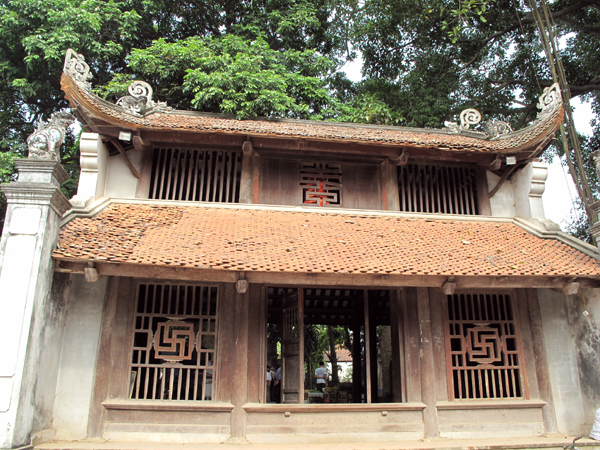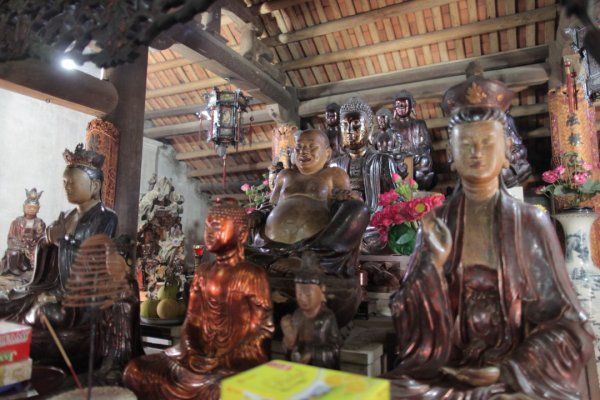Tailor Made Holidays with our travel experts
We'll do our best to call you within 48h

The pagoda was built during the Tran Dynasty (1225-1406) and still preserves many ancient artifacts. Mia Pagoda is also initially called Sung Nghiem Tu. Several years later, Lady Nguyen Thi Dong, also called Lady Mia, had the pagoda rebuilt and renamed. The pagoda has 287 statues of all sizes, among which are famous sculptures such as the statue of Buddha in the Himalayas and the statues of the Eight Vajra Deities. The largest one is the sculpture of Bat Bo Kim Cang located in the upper sanctuary. The pagoda preserves many ancient artifacts such as the great red bell made in 1743, the bronze gong (1846), and the Lady Mia stone tables, set up in 1632.
Mia Pagoda is one of famous pagoda of Duong Lam commune, Son Tay town. It is one of temples with the unique architecture. The entire temple was built of valuable timber and had "Muc" shaped architecture. Mia Pagoda is also known as Sung Nghiem Tu. It was built in the reign of Tran. In 17th century, there were many unique statues of Buddha, demonstrating the sublime art of artisans of casting, modeling, carving in ancient times.
As one of the 10 oldest temples in Vietnam, Mia pagoda has many most beautiful statues of Vietnam. Mia Pagoda was built during the Tran Dynasty before 1632 and still preserves many ancient artifacts. The pagoda is considered to store most art statues in Vietnam (287 statues). Sitting silently on the stone benches inside Mia pagoda and listening to the temple bell echoes. It is one of highlights of National relic complex - Duong Lam ancient village and is one of the famous tourist attractions of the capital Hanoi, attracting large amounts of tourists.

History
At the first time, Mia was a small pagoda, on XVII century the pagoda was deserted. In 1632, a concubine of the The Trinh Lords - Trinh Trang, Ms. Ngoc Dung came back to her hometown near Mia pagoda, She visited the pagoda and saw the deserted situation. She changed the situation by mobilizing local people to rebuild the pagoda. To show the respect to her, local people built the temple and also put her altar on this pagoda to worship after she passed away. Nowadays, local people still call her “Queen of Mia”. Event the pagoda was refurbished many times, but the altar of Ms. Ngoc Dung is still conserved carefully.
Architecture
Few steps through Mia local market, tourist easily find the Three Doors gate of the Mia pagoda. The top of the gate hang an ancient bell was found in 1745, and a flat bell was found in 1846. As almost other ancient Pagoda in Vietnam, this pagoda also has a hundreds years old giant banyan tree behind the gate with lush foliage and a peaceful quiet atmosphere.
Mia Pagoda The pagoda built as word shape – a traditional architecture style of Vietnam for the pagodas and temple - with three main parts: Tien Duong (front compartment), Dai Hung Bao Dien (the Great compartment) and Thuong Dien (the upper compartment). Tien Duong is the place for the guest to prepare the offering to offer Buddha. In the left side of Tien Duong is a giant stone stele on the turtle back was made in 1632. The stone stele was decorated by traditional patterns: dragons flanking a moon, chrysanthemum flower, lotus. Walking through Tien Duong is Dai Hung Bao Dien with a large number of Buddha statues. Worshiping the solemn Buddha statues while listening the peal of bell will help the guest retreats their souls. The last part also the most solemn part is Thuong Dien where setup Buddhist triangle statues. The corridors in two sides are setup eighteen Arhats Statues.
Statues of Buddha
Buddha statue at Mia pagoda is not only unique in appearance, but also rich in number. The pagoda has totally 287 Buddha statues, with 6 bronze statues, 107 wooden statues and 174 earthenware statues. Each statue has it own expression, design, color. One of the very beautiful statues here is Tuyet Son Statue (Historical Buddha statue). The Tuyet Son status shows appearance of Amitabha when he cultivates on Tuyet Son mountain (Himalaya mountain) with 0.76 meter height. The statue look quite thin with the face full of thoughts because of thinking for all people in the world. The Thi Kinh bodhisattva statue – the bodhisattva of Vietnamese people - is very beautiful also. The statue is a gentle lady with an angel face that is hug a baby. The statue is about the legend of Thi Kinh bodhisattva – a folk tale of Vietnamese people.
The architecture and statues system of Mia pagoda is recognized as on of the most important relics of the country. In May, 2006 Mia pagoda was listed in Vietnam Buddha culture record list of having largest number of art Buddha statues. The architecture and statues system of Mia pagoda is recognized as on of the most important relics of the country. In May, 2006 Mia pagoda was listed in Vietnam Buddha culture record list of having largest number of art Buddha statues.